Lawyers are taught that effective legal writing is clear, focused and succinct. The B.C. Court of Appeal will require careful adherence to those principles, even where proceedings are complex. The test remains the same: a party seeking to file a lengthy factum must provide “a convincing explanation as to why extra space is necessary”.
In the recent decision, Equustek Solutions Inc. v. Jack, 2022 BCCA 194 (Equustek), Justice Hunter emphasized the importance of conciseness in legal writing and summarized key first principles on factum drafting. Equustek reminds appellants that factums should provide an outline of the arguments that will be advanced, not a full argument of the appeal. The Court’s commentary adds to the growing jurisprudence on written advocacy and provides guidance that applies equally to all legal writing.
Factual background
In Equustek, the appellants brought an application for leave to file an 82-page factum, almost three times the normal 30-page limit.
The appellants’ argument for an 82-page factum was that the trial being appealed was highly complex. The underlying trial lasted 73 days and involved claims in breach of confidence, passing off, breach of copyright and conspiracy. The issue at trial was whether a product sold by the defendants was copied from the plaintiffs’ product, which required a significant amount of technical evidence.
The appellants also argued that the primary basis for the appeal was that the trial judge failed to consider material evidence supporting their claim. Therefore, the appellant argued, the appeal required a more detailed review of the evidence than usual.
The issue before the Court of Appeal on this application was whether the appeal was more than “reasonably complex”, therefore requiring a factum of more than 30 pages to allow the appellants to fairly present their appeal and, if so, what length of factum should be permitted.
The B.C. Court of Appeal’s decision
Justice Hunter did not grant leave for the appellants to file an 82-page factum but allowed them instead to file a 40-page factum due to the complicated factual matrix of the case.
The decision provides important principles for litigators drafting factums. Justice Hunter stated that the main purpose of a factum is to provide the court and the opposing parties with an outline of the arguments that will be advanced and a list of the authorities to be cited.
In particular, Justice Hunter stated that an appellant’s factum serves two purposes:
- First, it communicates to the respondent the issues in dispute so that the respondent can prepare a responsive factum.
- Second, it acquaints the court with the issues in dispute and the appellant’s position on those issues.
A factum also provides a helpful structure of the appellant’s position and authorities if the court reserves judgment.
Justice Hunter distinguished an appeal factum from post-trial written argument, where it is necessary to marshal all the evidence to persuade the trier of fact to make specific conclusions. In a factum, the statement of facts should not be a summary of the evidence, but rather of the facts that were found by the trial judge or are otherwise not in dispute. This is because appeals typically proceed on those undisputed facts, unless an appellant can convince the court that there was either no evidence to support a factual finding or the judge committed an obvious factual error that was material to the outcome.
Justice Hunter emphasized the importance of conciseness, stating that the 30-page limit is meant for complex cases, and that simpler cases can (and probably should) be dealt with in much shorter factums. Conciseness, Justice Hunter said, can be thought of as necessary for the proper administration of justice to ensure that appeals are properly focused while, at the same time, enabling the court to efficiently manage its business.
Update: The 30-page limit for a factum still applies after the transition to the new BC Court of Appeal Rules, B.C. Reg. 120/2022. While the page-limit is no longer set out in the Rules (formerly in Rule 22), it appears in the updated factum template.

